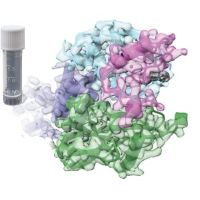Specification
| Organism | Homo sapiens (Human) |
| Expression Host | E.coli |
| Tag Info | N-terminal GST-tagged |
| Purity | Greater than 85% by SDS-PAGE |
| Uniprot ID | P61586 |
| Gene Names | RHOA |
| Alternative Names | Rho cDNA clone 12 ;h12 |
| Expression Region | Partial(1-191aa ) |
| Molecular Weight | 48.6 kDa |
| Protein Sequence | MAAIRKKLVIVGDGACGKTCLLIVFSKDQFPEVYVPTVFENYVADIEVDGKQVELALWDTAGQEDYDRLRPLSYPDTDVILMCFSIDSPDSLENIPEKWTPEVKHFCPNVPIILVGNKKDLRNDEHTRRELAKMKQEPVKPEEGRDMANRIGAFGYMECSAKTKDGVREVFEMATRAALQARRGKKKSGCL |
| Form | Liquid or Lyophilization |
| Buffer | The default storage buffer is Tris/PBS-based buffer, 5%-50% glycerol if the delivery form is liquid. The lyophilization buffer is Tris/PBS-based buffer, 6% Trehalose, pH 8.0 if the delivery form is lyophilized powder. Please contact us if you have any special requirment. |
| Reconstitution | Please reconstitute protein in deionized sterile water and we recommend that briefly centrifuge thevial prior to opening the vial .We recommend aliquot for long-term storage at -20℃/-80℃. |
Background
| Relevance | Regulates a signal transduction pathway linking plasma mbrane receptors to the assbly of focal adhesions and actin stress fibers. Involved in a microtubule-dependent signal that is required for the myosin contractile ring formation during cell cycle cytokinesis. Plays an essential role in cleavage furrow formation. Required for the apical junction formation of keratinocyte cell-cell adhesion. Serves as a target for the yopT cysteine peptidase from Yersinia pestis, vector of the plague, and Yersinia pseudotuberculosis, which causes gastrointestinal disorders. Stimulates PKN2 kinase activity. May be an activator of PLCE1. Activated by ARHGEF2, which promotes the exchange of GDP for GTP. Essential for the SPATA13-mediated regulation of cell migration and adhesion assbly and disassbly. The MO1-RHOA-DIAPH1 signaling pathway plays an important role in ERBB2-dependent stabilization of microtubules at the cell cortex. It controls the localization of APC and CLASP2 to the cell mbrane, via the regulation of GSK3B activity. In turn, mbrane-bound APC allows the localization of the MACF1 to the cell mbrane, which is required for microtubule capture and stabilization.Regulates a signal transduction pathway linking plasma mbrane receptors to the assbly of focal adhesions and actin stress fibers. Involved in a microtubule-dependent signal that is required for the myosin contractile ring formation during cell cycle cytokinesis. Plays an essential role in cleavage furrow formation. Required for the apical junction formation of keratinocyte cell-cell adhesion. May be an activator of PLCE1. Activated by ARHGEF2, which promotes the exchange of GDP for GTP. Essential for the SPATA13-mediated regulation of cell migration and adhesion assbly and disassbly. The MO1-RHOA-DIAPH1 signaling pathway plays an important role in ERBB2-dependent stabilization of microtubules at the cell cortex. It controls the localization of APC and CLASP2 to the cell mbrane, via the regulation of GSK3B activity. In turn, mbrane-bound APC allows the localization of the MACF1 to the cell mbrane, which is required for microtubule capture and stabilization . Regulates KCNA2 potassium channel activity by reducing its location at the cell surface in response to CHRM1 activation; promotes KCNA2 endocytosis |
| Involvement in Disease | |
| Subcellular Location | Cell membrane, Lipid-anchor, Cytoplasmic side, Cytoplasm, cytoskeleton, Cleavage furrow, Cytoplasm, cell cortex, Midbody, Cell projection, lamellipodium |
| Protein Families | Small GTPase superfamily, Rho family |
| Tissue Specificity | RHOA |
QC Data
| Note | Please contact us for QC Data |
| Product Image (Reference Only) |  |

